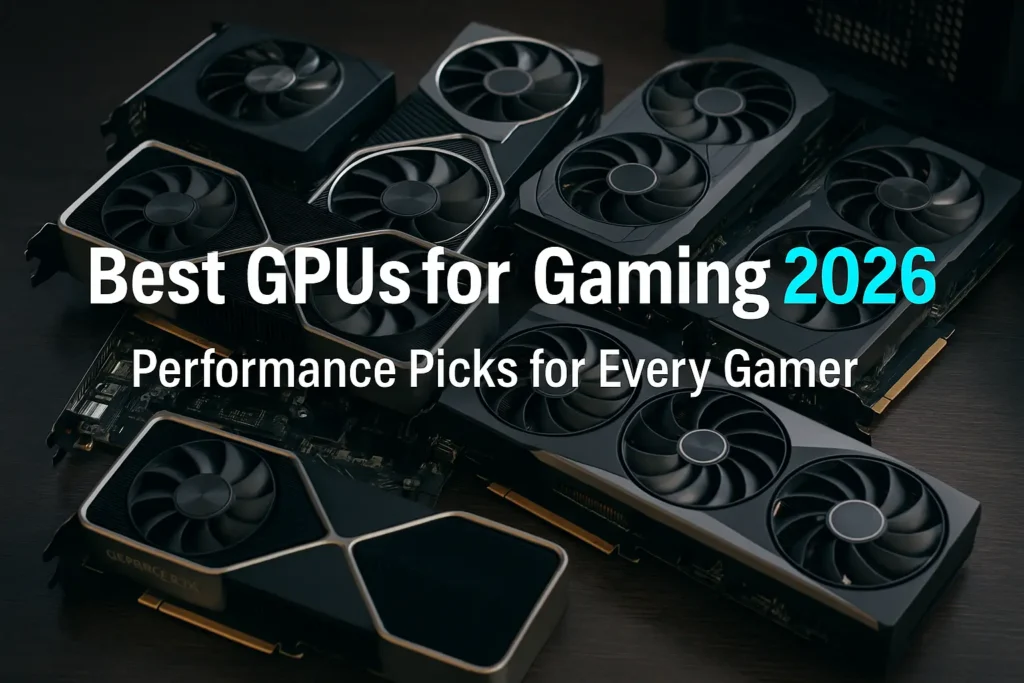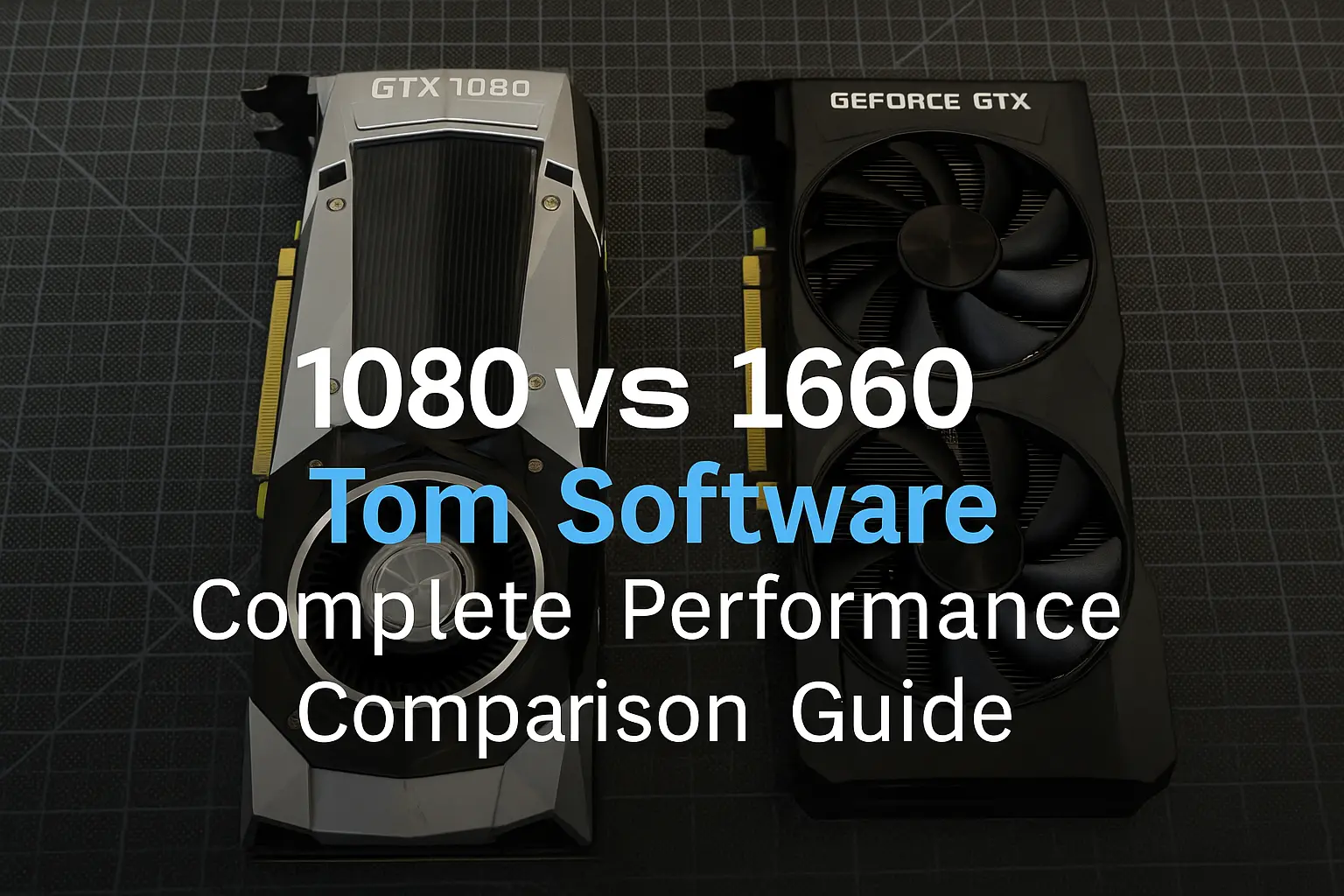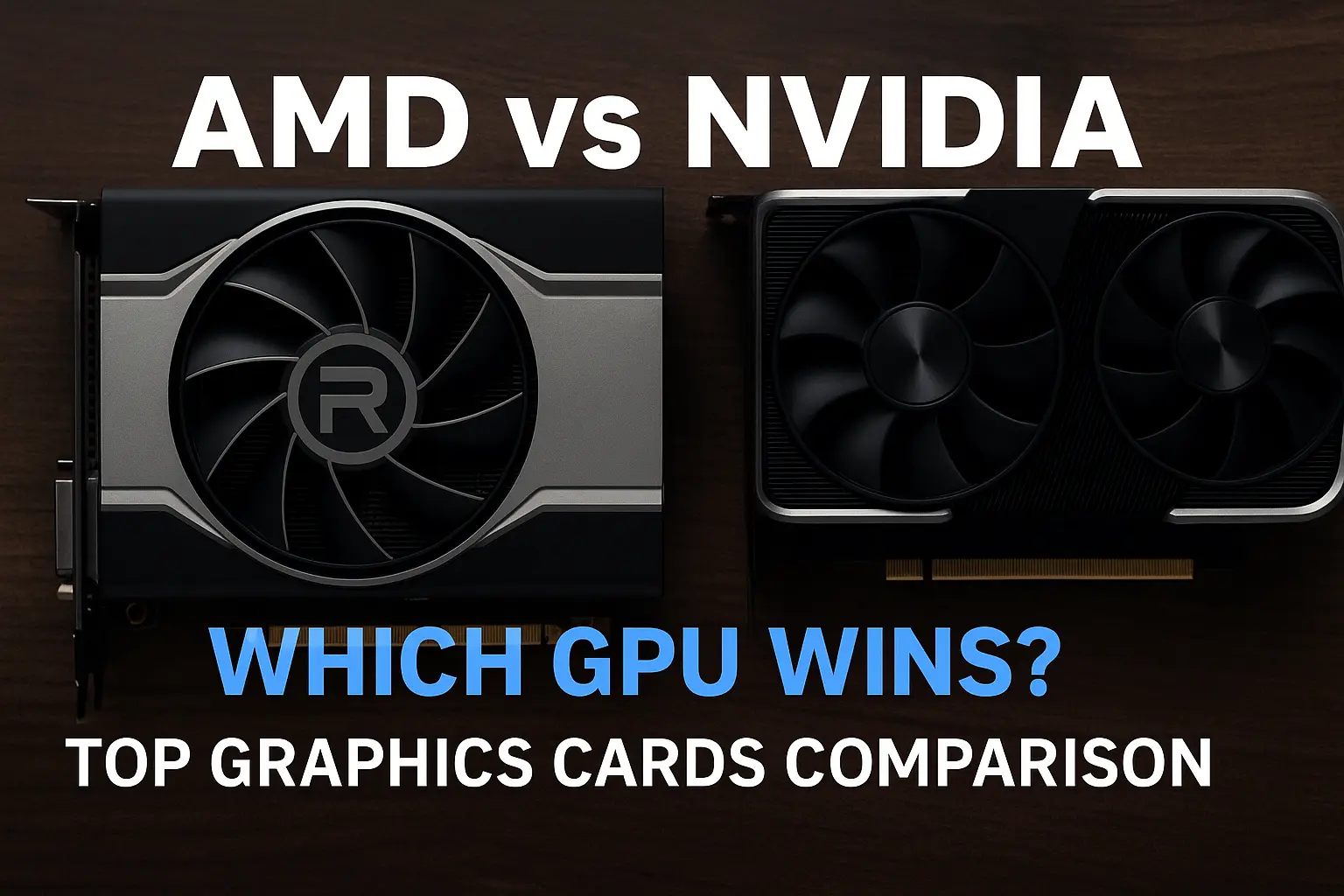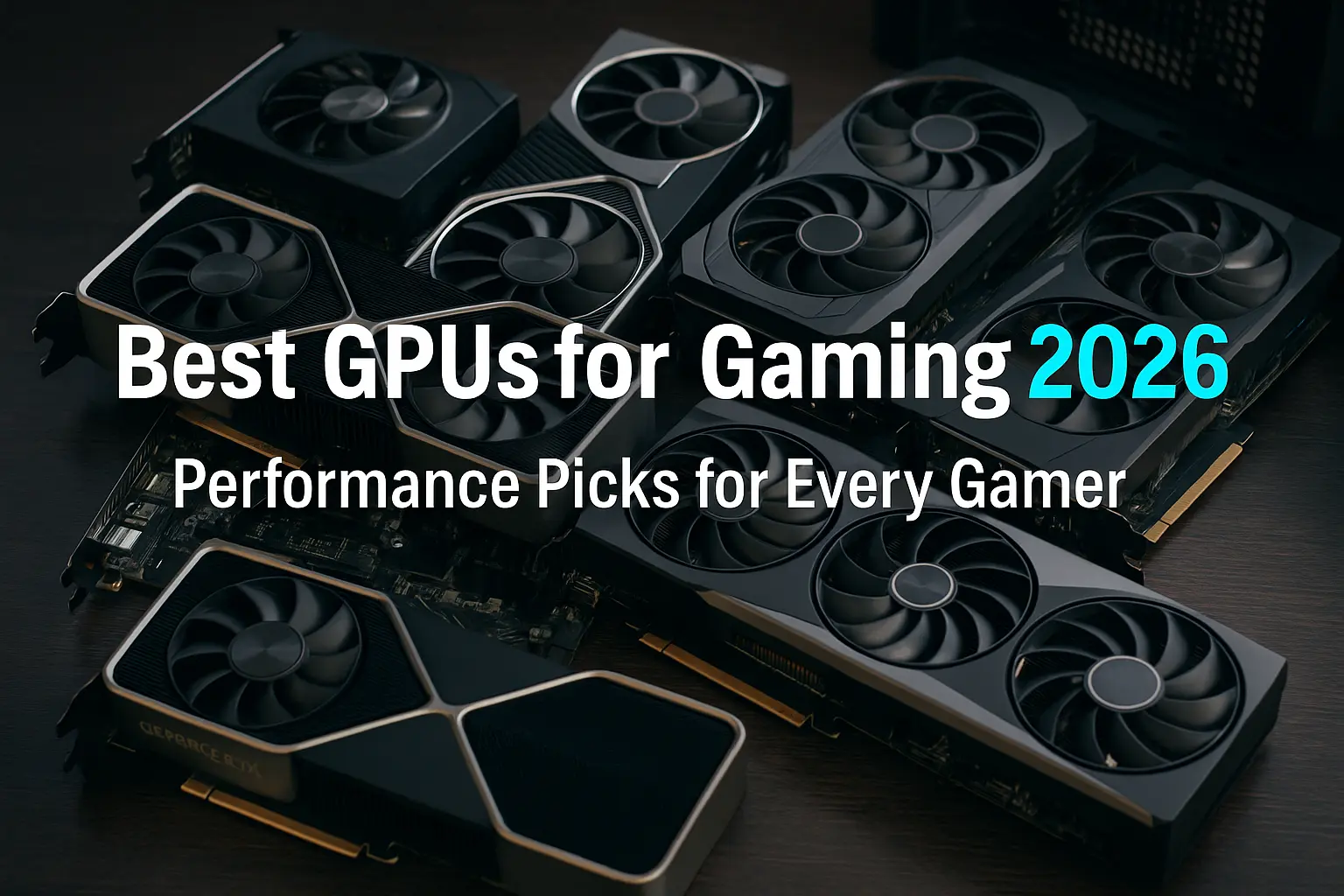Your current GPU is wheezing through modern games like a chain smoker climbing stairs, and you’re tired of playing everything on “potato” settings while your friends brag about their silky-smooth 4K gameplay.
You’ve got $800 burning a hole in your pocket, but the GPU market feels like a minefield of confusing model numbers, conflicting reviews, and that nagging fear you’ll buy the wrong thing and regret it for the next three years.
Here’s the reality: picking the best GPUs for gaming in 2026 isn’t about following some arbitrary “top 10” list written by someone who’s never actually gamed on these cards. It’s about understanding what each VGA card actually delivers for your specific games, resolution, and budget.
Whether you’re chasing 240fps in competitive shooters, trying to max out Cyberpunk 2077 with ray tracing, or just want to stream without your system melting, this guide cuts through the marketing nonsense.
We’ll break down the real-world performance of every major graphics card worth buying, from budget champions to high end GPU for gaming monsters, including detailed analysis of popular options like the 4070 GPU.
No fluff, no sponsored recommendations – just honest takes from someone who’s actually used these cards for the games you want to play.
What Makes a GPU Worth Your Money in 2026?
Before we dive into specific cards, let’s kill some myths. Raw specs don’t tell the whole story. VRAM matters more than you think. And that “4K gaming” marketing might not mean what you expect.
Real-World Performance vs. Marketing Claims
Graphics card companies love throwing around performance numbers that sound impressive but don’t reflect actual gaming experience. A GPU that averages 60fps might deliver terrible 1% lows, causing stuttering that ruins competitive gaming. Another card might excel at 1440p but choke at 4K due to insufficient VRAM.
The cards in this guide are ranked based on actual gaming performance across multiple titles, resolution scaling, and long-term viability—not synthetic benchmarks that don’t reflect real usage.
how much gaming performance depends on the CPU vs GPU learn here.
VRAM: The Spec Nobody Talks About (Until It’s Too Late)
Here’s what GPU manufacturers don’t want you to know: modern games are VRAM-hungry monsters. Trying to play modern AAA titles at high settings with only 8GB VRAM is like trying to edit 4K video on a laptop from 2018—technically possible, but painful.
VRAM Requirements by Resolution (2026 Reality Check):
| Resolution | Minimum VRAM | Comfortable Gaming | Future-Proof |
| 1080p | 8GB | 12GB | 16GB |
| 1440p | 12GB | 16GB | 20GB+ |
| 4K | 16GB | 20GB+ | 24GB |
See our guide on CPU vs GPU key differences and VRAM explained HERE.
Performance Tiers That Actually Make Sense
Forget the marketing categories. Here’s how GPUs actually perform:
- Esports Excellence: High refresh rate 1080p/1440p competitive gaming
- 1440p Masters: Beautiful visuals with solid frame rates at the sweet spot resolution
- 4K Capable: Can actually handle 4K gaming without looking like a slideshow
- 4K Dominant: Maxes out 4K gaming with ray tracing enabled
- Content Creation Powerhouse: Handles streaming, rendering, and gaming simultaneously
GPU Performance Comparison Table
| GPU Model | VRAM | 1080p Avg FPS | 1440p Avg FPS | 4K Avg FPS | Best Use Case | Price Range |
| RTX 4090 | 24GB | 165+ | 140+ | 85+ | 4K Gaming + Content Creation | $1,600+ |
| RX 7900 XTX | 24GB | 155+ | 125+ | 75+ | High-End 4K Gaming | $900+ |
| RTX 4080 | 16GB | 145+ | 115+ | 70+ | Premium 4K Gaming | $1,000+ |
| RX 7900 XT | 20GB | 135+ | 105+ | 65+ | 4K Gaming Value | $700+ |
| RTX 3090 Ti | 24GB | 140+ | 110+ | 70+ | Content Creation Legacy | $1,200+ |
| RX 6900 XT | 16GB | 130+ | 100+ | 60+ | 1440p High Refresh | $600+ |
| RTX 4070 Ti | 12GB | 120+ | 95+ | 55+ | 1440p Gaming Sweet Spot | $800+ |
| RX 6800 XT | 16GB | 115+ | 90+ | 50+ | 1440p Budget Performance | $500+ |
| RTX 4070 | 12GB | 110+ | 85+ | 45+ | 1440p Mainstream | $600+ |
| RX 6700 XT | 12GB | 100+ | 75+ | 40+ | 1080p/1440p Budget | $400+ |
Performance numbers based on AAA gaming averages across multiple titles
1. NVIDIA GeForce RTX 4090
The RTX 4090 isn’t just the fastest gaming GPU—it’s in a league of its own. This is the card you buy when money isn’t the primary concern and you want to max out every single setting while streaming to Twitch.
Real-World Performance
4K Gaming: Actually delivers playable frame rates (60-80fps) in demanding games like Cyberpunk 2077 with ray tracing enabled. Most other GPUs make compromises here.
1440p Gaming: Absolutely destroys everything at 120-165fps. Perfect for high refresh rate monitors and competitive advantage.
Content Creation: The 24GB VRAM handles 8K video editing, 3D rendering, and AI workloads that would choke other cards.
Why You’d Buy This Card
You’re building a no-compromise system, do serious content creation work, or game at 4K with maximum settings. The RTX 4090 also future-proofs your system for the next 4-5 years of demanding games.
Why You Wouldn’t
The price is brutal—$1,600+ for the card alone. It requires a 850W+ PSU and excellent case cooling. Most people would get 90% of the gaming experience from cards costing half as much.
Best For: 4K gaming enthusiasts, content creators, future-proofing
2. AMD Radeon RX 7900 XTX
AMD’s flagship fights back with impressive 4K performance and significantly better value than NVIDIA’s top-tier option. This is the card that proves you don’t need to mortgage your house for excellent 4K gaming.
Real-World Performance
4K Gaming: Delivers 65-85fps in most AAA titles at maximum settings. Ray tracing performance trails NVIDIA but rasterization is excellent.
1440p Gaming: Handles everything at 100-140fps. Perfect sweet spot for high refresh rate gaming without overkill.
Value Proposition: Costs $700-800 less than RTX 4090 while delivering 85% of the performance in most games.
AMD’s Advantages
The 24GB VRAM future-proofs against games that demand large texture pools. Power efficiency improved dramatically over previous generations. FSR (FidelityFX Super Resolution) support is growing rapidly.
NVIDIA Still Wins At
Ray tracing performance, DLSS adoption, and content creation features. If you’re heavily into streaming or video editing, NVIDIA’s ecosystem remains stronger.
Best For: High-end gaming value seekers, 4K gaming on a budget
3. NVIDIA GeForce RTX 4080
The RTX 4080 sits in GPU no-man’s land—too expensive to be good value, not powerful enough to justify the premium over cheaper options. But for specific use cases, it makes sense.
When RTX 4080 Makes Sense
You want NVIDIA’s ray tracing and DLSS advantages but can’t justify RTX 4090 pricing. The 16GB VRAM handles 4K gaming comfortably, and the card runs cooler and quieter than the flagship.
The Value Problem
At $1,000+, you’re paying a massive premium over the RTX 4070 Ti for modest performance gains. Most people would be happier saving $200+ and buying the Ti variant.
Performance Reality
4K Gaming: Good performance (60-75fps) in most titles with high settings. Ray tracing might require DLSS for smooth frame rates.
1440p Gaming: Overkill performance that won’t be fully utilized unless you’re gaming at 165Hz+.
Best For: NVIDIA ecosystem preference with 4K gaming requirements
4. AMD Radeon RX 7900 XT
This is AMD’s most sensible high-end option. The RX 7900 XT delivers excellent 4K gaming performance without the premium pricing of flagship cards from either manufacturer.
The Sweet Spot Card
4K Performance: 60-75fps in demanding games with high settings. Occasionally requires medium settings for consistent 60fps in the most demanding titles.
1440p Excellence: Absolutely crushes 1440p gaming at 100-130fps. Perfect for high refresh rate monitors.
VRAM Advantage: 20GB VRAM provides more headroom than most competing NVIDIA cards.
Why This Over Competitors
Significantly cheaper than RTX 4080 while delivering similar gaming performance. The extra VRAM provides better longevity. AMD’s software stack continues improving rapidly.
The Tradeoffs
Ray tracing performance still trails NVIDIA. Content creation features aren’t as mature. Some games heavily favor NVIDIA optimization.
Best For: 4K gaming value, 1440p high refresh rate gaming
5. NVIDIA GeForce RTX 3090 Ti
The RTX 3090 Ti represents last-generation flagship performance that’s still relevant in 2026. Think of it as the RTX 4090’s older, slightly less capable sibling that costs significantly less.
Legacy Flagship Value
4K Performance: Still delivers 60-70fps in most games with high settings. The 24GB VRAM handles memory-intensive scenarios better than newer cards with less VRAM.
Content Creation: Excellent for video editing, 3D rendering, and AI workloads. The Ampere architecture remains solid for professional applications.
Why Buy Last-Gen Flagship
Often available for $1,200-1,400, providing RTX 4080-level gaming performance with more VRAM. Established driver support and wide game compatibility.
The Downsides
Higher power consumption than current-gen alternatives. Missing newer features like AV1 encoding. Prices haven’t dropped as much as expected.
Best For: Content creators needing lots of VRAM, 4K gaming on a budget
6. AMD Radeon RX 6900 XT
The RX 6900 XT represents AMD’s previous-generation flagship that’s aged surprisingly well. At current prices, it’s one of the best value propositions for high-end 1440p gaming.
The 1440p King
1440p Performance: Delivers 90-120fps in most AAA titles with maximum settings. Perfect for 144Hz gaming without compromises.
4K Capability: Can handle 4K gaming at 50-65fps with some settings adjustments. Not ideal for 4K but capable when needed.
Value Champion: Often available for $600-700, providing excellent price-to-performance.
RDNA 2 Strengths
Excellent power efficiency, strong rasterization performance, and 16GB VRAM that’s aging well. SAM (Smart Access Memory) provides additional performance with AMD CPUs.
Where It Struggles
Ray tracing performance is mediocre compared to NVIDIA alternatives. Missing newer features like FSR 3.0 support. Driver updates are less frequent for older generation cards.
Best For: 1440p high refresh rate gaming, budget-conscious 4K gaming
7. NVIDIA GeForce RTX 4070 Ti
The 4070 GPU Ti variant represents NVIDIA’s attempt at a 1440p gaming sweet spot card. It delivers solid performance but faces tough competition from AMD alternatives.
1440p Gaming Excellence
1440p Performance: Handles virtually everything at 80-110fps with maximum settings. Ray tracing performance is excellent with DLSS enabled.
4K Limitations: Can manage 4K gaming in less demanding titles, but 12GB VRAM becomes limiting in memory-intensive games.
DLSS Advantage
NVIDIA’s DLSS 3.0 provides significant performance boosts in supported games. The technology is more mature and widely supported than AMD’s FSR.
Value Concerns
At $800+, it faces strong competition from AMD cards offering more VRAM for similar money. The performance gap over the standard RTX 4070 isn’t always justified.
Ray Tracing King
For gamers who prioritize ray tracing and have DLSS-supported games, the RTX 4070 Ti provides the best experience in this price range.
Best For: 1440p ray tracing gaming, NVIDIA ecosystem preference
8. AMD Radeon RX 6800 XT
The RX 6800 XT has become one of the best value high-performance cards available. At current pricing, it delivers excellent 1440p performance and decent 4K capabilities.
The Value Performance Champion
1440p Gaming: Consistently delivers 75-100fps in AAA titles with high settings. Competitive esports titles run at 150+ fps easily.
4K Potential: Can handle 4K gaming at 45-60fps with some settings compromises. The 16GB VRAM helps with texture-heavy games.
Price Advantage: Often available for $500-600, providing exceptional value for the performance delivered.
RDNA 2 Benefits
Excellent power efficiency, strong performance scaling with AMD CPUs via SAM, and robust 16GB VRAM allocation that’s aging well.
The Compromises
Ray tracing performance is weak compared to NVIDIA alternatives. Software features lag behind NVIDIA’s ecosystem. Driver support prioritizes newer generation cards.
Best For: Budget-conscious high performance, 1440p gaming value
9. NVIDIA GeForce RTX 4070
The standard 4070 GPU represents NVIDIA’s mainstream offering for 1440p gaming. It’s a solid card that delivers good performance but faces value challenges.
Mainstream 1440p Gaming
1440p Performance: Handles most games at 70-95fps with high settings. DLSS provides significant performance boosts in supported titles.
Power Efficiency: Excellent performance per watt, making it ideal for smaller cases and lower-wattage PSUs.
The VRAM Concern
12GB VRAM is adequate for current games but might become limiting as games become more memory-intensive. 4K gaming is possible but often requires settings compromises.
DLSS Benefits
NVIDIA’s upscaling technology significantly extends the card’s capability, especially for ray tracing scenarios. The technology continues improving with each game update.
Competition Pressure
AMD alternatives often provide more VRAM for similar money. The price-to-performance ratio isn’t as compelling as AMD’s competing cards.
Best For: Mainstream 1440p gaming, small form factor builds
10. AMD Radeon RX 6700 XT
The RX 6700 XT represents the budget end of high-performance gaming. While it’s the “weakest” card on this list, it still delivers excellent 1080p performance and decent 1440p gaming.
Budget High-Performance Gaming
1080p Gaming: Absolutely destroys 1080p gaming at 90-130fps in virtually every title with maximum settings.
1440p Capability: Handles 1440p gaming at 60-85fps, though some demanding titles might require settings adjustments.
Value Leadership: Often available for $400-500, providing excellent performance per dollar.
The Sweet Spot Card
For many gamers, the RX 6700 XT provides all the performance they actually need. Most people game at 1080p or 1440p, making more expensive cards overkill.
Forward-Looking Concerns
12GB VRAM should remain adequate for several years, but the computational power might become limiting before VRAM does.
Best For: Budget-conscious gaming, 1080p high refresh rate, entry-level 1440p
GPU Buying Decision Framework
Instead of just picking the “best” GPU, match your card to your actual needs. Here’s the decision tree that actually works:
Resolution Priority Method
1080p Gamers: RX 6700 XT or RTX 4070 provide more performance than you need. Save money unless you’re targeting 240Hz gaming.
1440p Gamers: RTX 4070 Ti, RX 7900 XT, or RX 6800 XT represent the sweet spot for this resolution.
4K Gamers: RTX 4090, RX 7900 XTX, or RTX 4080 are your only real options for smooth 4K gaming.
Budget-First Approach
Under $500: RX 6700 XT dominates this price range
$500-$800: RX 6800 XT or RTX 4070 provide excellent value
$800-$1200: RX 7900 XT offers the best price-to-performance
$1200+: RTX 4090 if money isn’t the primary concern
Use Case Optimization
Competitive Gaming: Prioritize consistent frame times over peak performance. RTX 4070 or RX 6800 XT work well.
Single-Player Gaming: Visual quality matters more. RTX 4070 Ti or RX 7900 XT provide the best balance.
Content Creation: VRAM and compute performance matter. RTX 4090 or RX 7900 XTX provide the capabilities needed.
Stop Overthinking and Start Gaming
The GPU market in 2026 offers excellent options across every price range, but the “best” card depends entirely on what you actually do with your system. A $400 RX 6700 XT might provide everything you need for 1080p gaming, while content creators might require the raw power of an RTX 4090.
The sweet spot for most gamers remains 1440p gaming with cards like the RX 7900 XT or RTX 4070 Ti. These provide beautiful visuals, smooth frame rates, and reasonable pricing without the premium of 4K-focused cards.
Frequently Asked Questions About Gaming GPUs
Is 2160p better than 1440p?
2160p (4K) provides sharper image quality but requires significantly more GPU power. For most gamers, 1440p provides the best balance of visual quality and performance. You need at least an RTX 4080 or RX 7900 XTX for smooth 4K gaming.
Beste Grafikkarten für Gaming
The best graphics cards for gaming depend on your resolution and budget. For 1440p gaming, the RX 7900 XT and RTX 4070 Ti offer excellent performance. For 4K gaming, consider the RTX 4090 or RX 7900 XTX for optimal experience.
Good video card for streaming?
For streaming, look for cards with hardware encoding capabilities. NVIDIA cards with NVENC (RTX 4070 and above) provide excellent streaming quality with minimal performance impact. The RTX 4070 Ti offers a good balance of gaming performance and streaming capabilities.
Remember:
Your GPU is only as good as the rest of your system. A high-end graphics card paired with a weak CPU creates bottlenecks that waste money and performance. Use our PC Bottleneck Calculator to ensure your entire system works together efficiently, delivering the gaming experience you actually paid for rather than leaving performance on the table.





